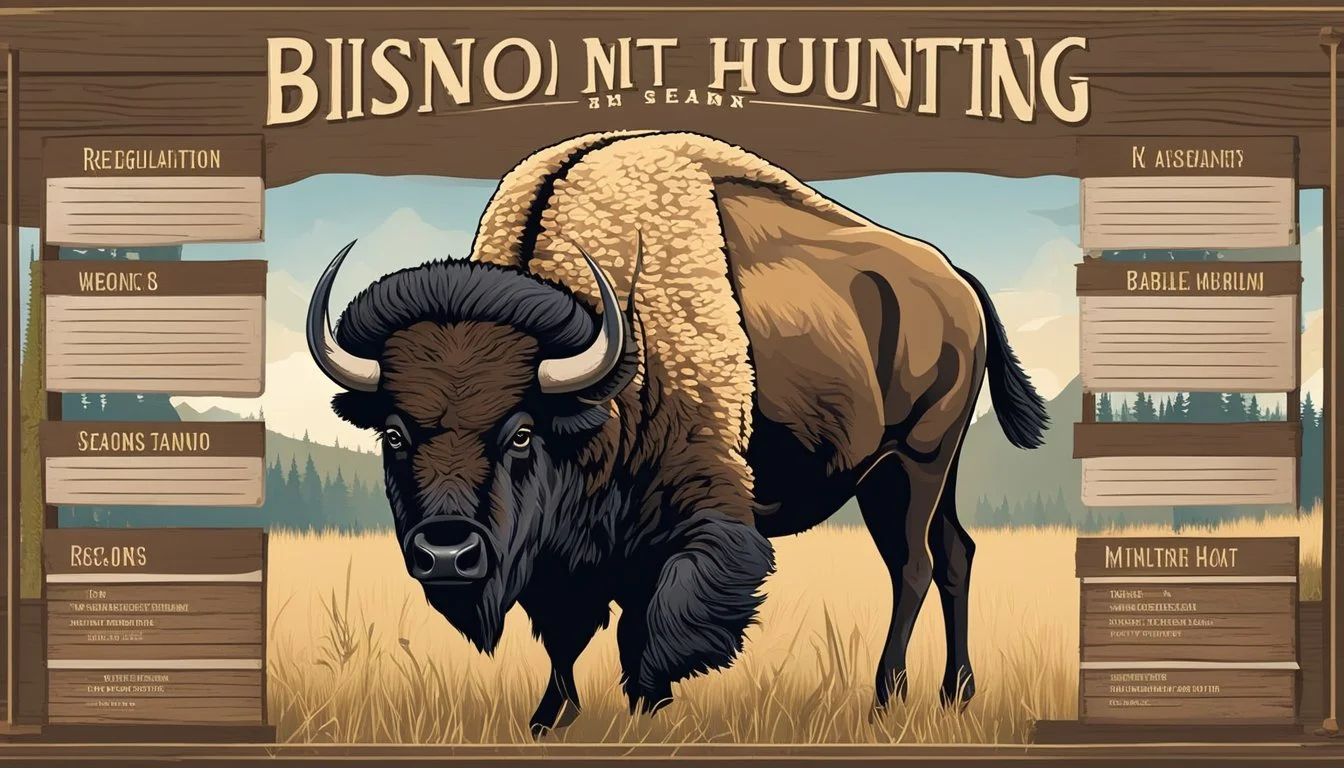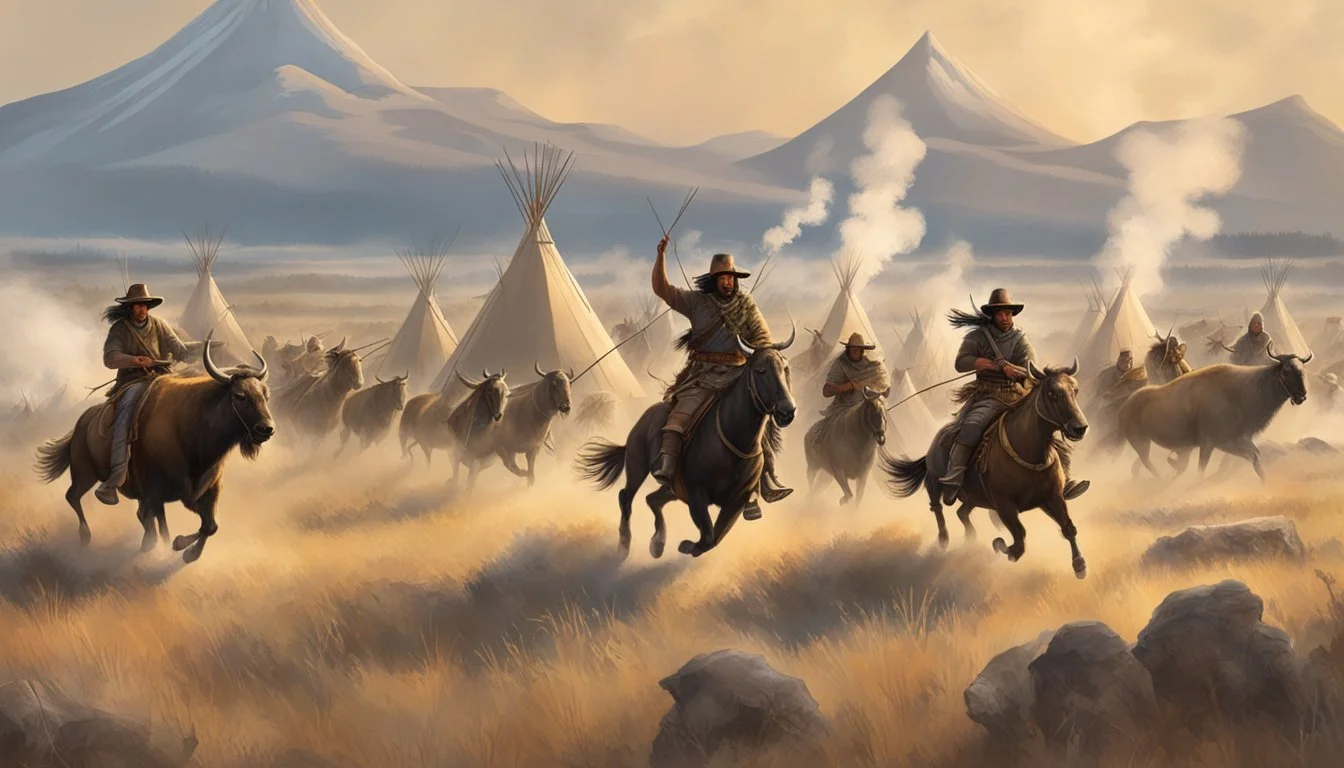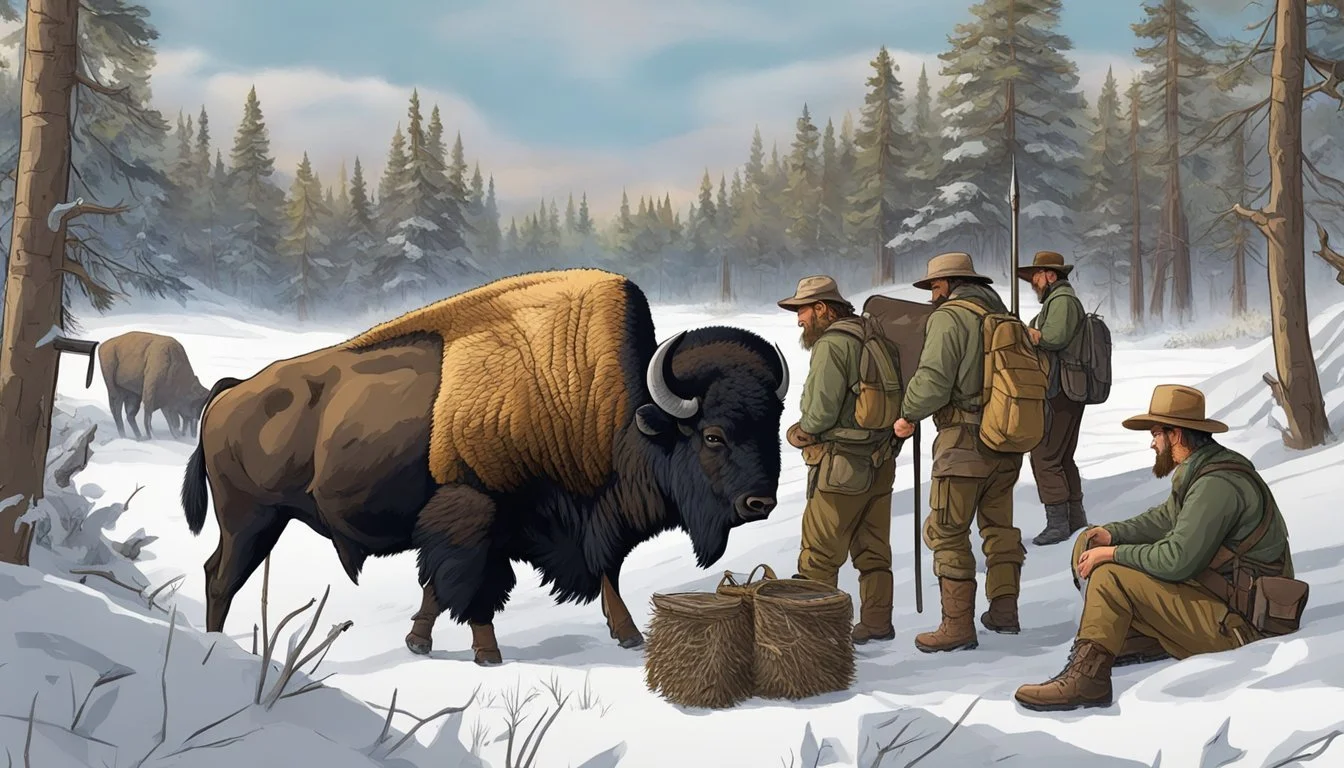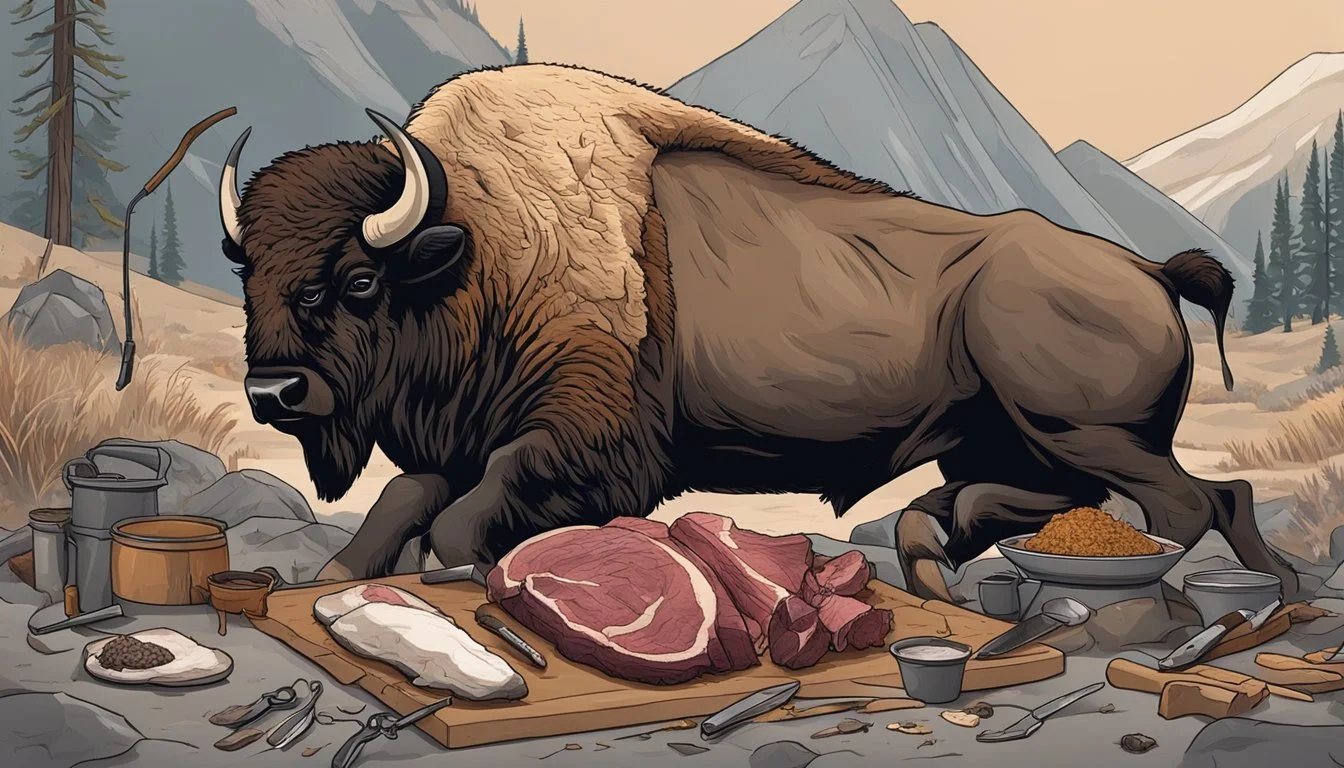Bison Hunting Seasons
Regulations and Best Practices for Hunters
This Article is Part of Our Guide on Hunting Seasons for Over 70 Common Game Species
Bison (What wine goes well with bison?) hunting in North America has deep historical roots, serving as a significant source of sustenance and cultural importance for indigenous populations and later for European settlers. Presently, hunting these majestic animals, also known as American bison or buffalo, is highly regulated to ensure sustainable populations. In states like Montana, Wyoming, Arizona, Alaska, and Utah, bison hunting seasons are established and governed by state wildlife agencies, with detailed rules on licenses, fees, and application deadlines.
Modern bison hunting often requires navigating a competitive lottery system to obtain the limited tags available for free-range hunts, reflecting the rarity and conservation status of the species. Hunters who are successful in drawing a permit must adhere to strict guidelines and seasons specifically designated for bison. For those not drawn in the lottery, opportunities to hunt bison on private ranches exist, offering a less restricted but equally regulated experience.
The experience of hunting bison today retains many traditional elements, with the added responsibility of contributing to the careful management and preservation of this iconic North American species. Hunters participating in bison hunts contribute to the controlled conservation efforts, and often engage in a practice that is steeped in a reverence for the animal and its habitat, continuing the legacy of hunting as a means of connecting people to the natural world and managing wildlife populations carefully.
Bison Species and Habitats
This section explores the distinctive characteristics of the American bison, their varied habitats across North America, and the locations of some notable bison herds.
American Bison Characteristics
The American bison, the largest land animal in North America, presents a robust figure with males standing up to 6 feet tall at the shoulder and weighing more than a ton. They have a shaggy mane of dark brown hair on their heads and forequarters, a distinct hump at their shoulders, and short, curved horns. Bison can be distinguished into two main subspecies: the wood bison, which are larger and found mostly in the boreal forests of Canada, and the plains bison, typically seen across the grasslands and prairies of the United States and Canada.
Bison Habitats in North America
Bison habitats span a variety of grassland ecosystems, including the Great Plains of the United States and the prairies and parklands of Canada. These bison prefer:
Open grasslands for grazing
Prairies that provide a mix of grasses and herbs
Boreal forests in areas like Canada, mainly for wood bison Bison favor these habitats for their ample food sources and the vast spaces that can support their herding behavior.
Some Bison Herds and their Locations
Several high-profile bison herds roam across North America, each adapted to its local environment. Notable herds include:
The Yellowstone National Park herd in the United States, one of the last free-ranging bison populations residing in their natural habitat on the Great Plains
The Wood Buffalo National Park herd in Canada, which primarily consists of wood bison situated in the boreal forests
The Delta Junction herd in Alaska, known for being managed through conservation efforts to maintain their numbers and habitat Each location supports a unique ecosystem that is crucial for sustaining their respective bison populations.
Bison Hunting Regulations
Bison hunting is closely regulated to ensure sustainable practices and to align with conservation goals. Regulations vary by federal and state entities, and hunters often need to navigate lotteries or special drawings to obtain permits.
Federal and State Bison Regulations
Federal and state agencies implement strict regulations for bison hunting to manage populations and maintain ecological balance. In the United States, the U.S. Fish and Wildlife Service (FWS) oversees national wildlife refuges like the National Elk Refuge in Wyoming, emphasizing habitat conservation for native species. State regulations, applied by entities such as the Wyoming Game and Fish Department and Montana Fish, Wildlife & Parks, set age requirements and season dates.
Key points:
A hunter must be at least 14 years old by a specific date to apply for a license.
Public comment is considered during the commission meeting before finalizing regulations.
Bison Lottery and Special Drawings
Obtaining a permit to hunt bison often involves navigating a lottery or a special drawing. The limited availability of tags for free-range bison hunts requires applicants to participate in these competitive processes.
Important details:
Residents and non-residents can apply, with certain states offering different quotas.
Special drawings may be held for hunting in areas like the National Elk Refuge.
Hunting Bison on Private Ranches
In some states, including Utah and Montana, hunting bison on private ranches, such as West Canyon Ranch, is an alternative option. These ranches operate under different regulations, allowing for more controlled hunting experiences.
Points to note:
Hunting on private property does not generally require participation in a lottery.
Regulation and permits are still required but are managed by the ranch or private entity.
By adhering to these guidelines, hunters contribute to buffalo conservation and support ethical and sustainable hunting practices.
Bison Hunting Techniques
Bison hunting requires specific methods and equipment to be successful. From the traditional to the modern, hunters must understand their prey and employ strategies that are both effective and respectful of the animal and the environment.
Traditional Hunting Methods
Traditional bison hunting involved a deep understanding of the animal's behavior. Early hunters used bows and arrows for silent, close-range shots. Employing horses was another age-old tactic, facilitating mobility for hunters to effectively approach bison herds. The element of surprise was vital; hunters disguised their scent and sound, approaching herds with caution to remain undetected.
Modern Hunting Equipment
Today, rifles have largely replaced bows as the favored tool in bison hunting. Hunters use high-caliber rifles capable of delivering a quick, humane kill due to the bison's substantial size and tough hide. Spot-and-stalk is the favored hunting method with modern equipment, demanding patience as hunters observe bison from a distance, typically while the animals are grazing, and then move in carefully for a clear, ethically shot.
Main Equipment
Rifle (high caliber)
Binoculars (for spotting)
Camouflage clothing
Wind direction indicator (to manage odor detection)
Tracking and Stalking Bison
Efficient tracking includes interpreting signs such as tracks, scat, and rubbed vegetation. Once on a herd's trail, stalking becomes a critical part of the approach. Hunters must keep downwind to avoid alerting bison of human odor. A successful bison hunting experience is often attributed to a hunter's ability to stealthily navigate to a position that affords a clear, responsible shot.
Stalking Techniques
Assess wind direction constantly
Move slowly and silently
Use natural cover for concealment
Observe herd dynamics; target appropriately
Hunting Seasons and Locations
The hunting of bison in North America is regulated with specific seasons and locations to ensure sustainable practices. These vary by region and are often coupled with strict permitting processes.
Best Times for Hunting Bison
The ideal time for hunting bison tends to be during the winter months, when they are more easily tracked in the snow and their migration patterns bring them to more accessible areas. Montana and Alaska, for instance, offer hunting seasons that typically align with these periods.
Prime Bison Hunting Grounds
Bison can be found across various hunting grounds in the United States including:
Plains such as those in Montana, where wild bison herds are often hunted.
Yellowstone National Park’s outskirts, where hunting is strictly regulated to manage the bison population.
Private ranches in states like Utah and Arizona provide alternative hunting opportunities outside of free-range hunts.
Hunting Districts and Access
Gaining access to hunting districts requires adherence to state and federal regulations. For instance:
In Montana, hunting districts are often part of or adjacent to reservations, and hunters must have appropriate permissions and abide by district-specific rules.
The National Elk Refuge in Wyoming outlines clear restrictions for access to bison hunting areas within its boundaries. Access routes and parking lot designations are strictly enforced.
Alaska offers unique hunting districts due to its vast wilderness, though accessibility can be challenging due to the terrain.
Bison Hunting Challenges
Bison hunting is a demanding sport that presents numerous challenges, ranging from the rugged environment bison inhabit, to their unpredictable behavior, and the potential for hunter-bison conflicts.
Weather and Terrain Difficulties
The vast plains and hills where American bison roam can subject hunters to severe weather conditions, especially in winter. Hunters must navigate this:
Winter weather: Snow, ice, and cold temperatures challenge hunters' endurance and safety.
Terrain: The plains and hills can be treacherous with:
Uneven grounds
Hidden obstacles
Limited accessibility
Hunters must prepare for the physical toll these elements take on the body and plan accordingly for a successful hunt.
Bison Behavior and Defense
Bison are not only fast but also unexpectedly agile. Their behavior includes:
Defense mechanisms:
Tail position: Warning sign of a potential charge
Herd protection: Bison often protect injured members, complicating the hunter's approach
Understanding bison behavior is key to safely coordinating a hunt, as they can jump considerable distances and charge with little warning if provoked or threatened.
Hunter-Bison Conflicts
Conflicts between hunters and bison arise due to:
Territorial issues: Bison are protective of their space and herds.
Mistaken identity: In areas with mixed wildlife, hunters may accidentally target non-game species or young bison, leading to legal and ethical issues.
Hunters need to distinguish their target with precision to avoid unnecessary conflict and to ensure a legal and ethical hunt.
Cultural and Historical Context
The historical and cultural ties to bison in North America are deeply interwoven with the continent's ecology and the heritage of its peoples. This section uncovers the relationship humans have had with bison, spanning from indigenous reverence and reliance to the challenges of conservation in the present day.
Historic Significance of Bison
Historically, the bison played a pivotal role in the shaping of economies and lifestyles across the North American plains. During the 19th century, the United States witnessed a dramatic decrease in the bison population due to extensive hunting as the nation expanded westward. This near-extinction event was catalyzed by a number of factors, including the desire for bison hides and meat, and, as a byproduct, the intent to suppress the native Plains Indians by disrupting their primary food source.
Bison in Native American Culture
For the Plains Indians, the bison was more than a food source; it was central to their culture, spirituality, and economy. Traditional uses of the bison included:
Food: Bison meat was a staple, often prepared as pemmican for long-term storage.
Materials: Hides were used for shelter and clothing, bones for tools, and sinews for bowstrings.
The bison's importance extended to the spiritual realm, with many tribes engaging in ceremonies and practices that honored the bison's contribution to their survival.
Conservation and Restoration Efforts
With conservation efforts coming into effect during the 20th century, the bison population has slowly begun to recover. Entities like the Buffalo Conservation Society and various government bodies have worked to:
Protect existing herds through legal frameworks.
Reintroduce bison to their native habitats through carefully managed programs.
Modern conservation efforts also acknowledge the historical significance of bison within indigenous cultures, incorporating traditional ecological knowledge into modern bison management strategies.
Preparing for a Bison Hunt
Before a hunter embarks on a bison hunt, meticulous preparation in terms of physical fitness, honing hunting skills, understanding game laws, and arranging logistics is critical.
Physical and Skill Requirements
Bison hunting demands a significant level of physical fitness; hunters should be able to navigate difficult terrain and possibly track animals over long distances. Proficiency with firearms or archery equipment is vital, as is the ability to judge distances and shoot accurately. Skills such as tracking, field dressing, and the ability to quickly adapt to changing scenarios are equally essential. Hunters often carry gear for extended periods, so stamina and strength training are beneficial.
Planning and Logistics
Careful planning for a bison hunt includes considering the time of year and the location. Most open-range bison hunts occur during the fall, specifically October and November, except in regions like Alaska, where seasons may differ. Transportation to and from the hunting area, as well as for the retrieval of the bison, should be arranged in advance. For guided bison hunts, coordination with professional guides ensures hunters are supported with local knowledge and expertise. Logistics cover:
Transport and accessibility of hunting area
Temporary accommodation if necessary
Proper gear for weather conditions
Legal and Ethical Considerations
Bison hunters must be well-informed of all pertinent regulations and secure the necessary permissions to hunt bison legally. Hunters are responsible for understanding the ethical considerations of bison hunting, which include respect for the species, adherence to fair chase principles, and contributions to bison conservation efforts. Compliance with hunting regulations and support for preservation initiatives are also integral to the practice of the sport. It is important to check if the area requires additional permissions and to take note of the following:
Permissions: Hunting licenses, tags, and special permits
Regulations: Season dates, bag limits, and legal methods of take
Conservation: Support for efforts to maintain healthy bison populations
Post-Hunt Process
After a successful bison hunt, the process that follows is critical. It involves proper handling of the meat, utilizing the bison for its materials, and sharing the experience for educational purposes and stories.
Processing the Bison Meat
Once a bison is harvested, prompt processing of the meat is crucial to preserve its quality.
Field Dressing: Immediately after the kill, hunters should begin field dressing to cool the meat and prevent spoilage.
Quartering: Bison are large animals, so meat is often quartered to transport from the hunting site.
Aging: Proper aging allows enzymes to break down muscle fibers, resulting in tender meat.
Butchering: Skilled butchering can maximize meat yield and ensures various cuts are properly handled.
Storage: Meat should be quickly frozen to maintain freshness. Using vacuum-sealed bags can extend its life.
Sale Regulations: Hunters should be aware of local laws regarding the sale of bison meat, as it's illegal in some areas without proper permits.
Bison Trophies and Material Uses
Bison provide more than meat; their trophies and materials are valued parts of hunting tradition.
Skull and Horns: The skull, often with horns attached, is a sought-after trophy that requires careful cleaning and preparation.
Hide: Bison hides can be tanned and used for leather goods like clothes and accessories.
Conservation: Bison parts should be utilized fully to honor the animal and support conservation efforts.
Sharing the Hunting Experience
Sharing the hunting experience and stories is an integral part of the hunt that fosters community and education.
Photographing: Taking photos throughout can capture the essence of the hunt for sharing.
Storytelling: Hunters often share their experiences verbally, promoting hunting traditions and ethical practices.
Conservation Education: Through sharing, hunters educate others on sustainable hunting and the role it plays in bison conservation.
Frequently Asked Questions
Is bison hunting legal in the United States?
Yes, bison hunting is legal in select areas of the United States, including certain public lands where herd culling is necessary for ecological balance, and on private ranches that offer managed hunting experiences.
What are the regulations for bison hunting?
Regulations can vary by location. Hunters should consult with local wildlife authorities or the U.S. Fish and Wildlife Service for specific information about permits, season dates, and legal hunting practices.
When can hunters book a bison hunt?
Booking times can differ depending on the provider. Some ranches allow repeat customers to book as early as January, while new customers may need to wait until February or later. Always check with the ranch or provider for specific booking dates.
What equipment is required for bison hunting?
Hunters should verify if there are any equipment restrictions, such as the use of archery over firearms, which can vary by region. They must also complete any required orientations or safety briefings.
Clothing for Hunts:
Summer: Light clothing suitable for up to 85 degrees Fahrenheit.
Winter: Warm clothing, shoes, and gloves for temperatures as low as 30 below zero. Snowmobiles may be used in deep snow conditions.
For detailed information on bison hunting in a specific region, hunters are advised to reach out to local wildlife management agencies or hunting providers.







